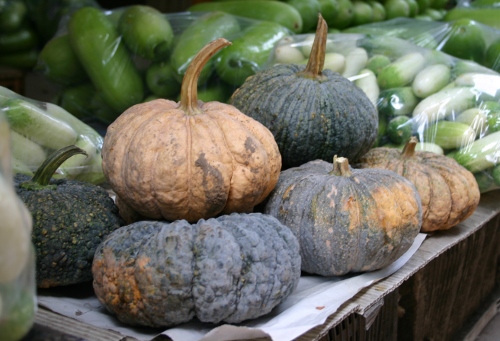Thai golden pumpkins (fak tong) are perhaps more ’natural’ than their North American cousins. As with many other fruits and vegetables, looks are not considered as important as taste for Thais. Although the fruit is thought to have originated in North America, Thai pumpkins are not like the unblemished clear skinned orange squash used to make Jack-o-Lanterns. They’re usually either green or even gray in color, with occasional orange blotches and quite bumpy skin. They’re also generally smaller than the huge ones often favored by the yanks. It’s just as well. I can’t imagine trying to fill an American “super-sized” pumpkin with custard, let alone fit it whole into a pot to cook it.

Pumpkins, along with their other squash relatives, are quite easy to grow in the cool hills around Chiang Mai. While traveling through the mountains along the winding roads, with fields of cabbage, corn, lettuce and other vegetables stretching over the rolling countryside into the distance, you will usually see pumpkin vines tumbling down the steep banks of the roadside and other difficult to cultivate areas. The vines are so aggressive that the farmers just toss the seeds onto any unused plot of land and leave them to their own devices.
Once they have ripened, the flattened squash will be taken down to the markets. Each person seems to have their own method for picking out the best pumpkins. Some prefer to rap the outside and select the pumpkin that has a certain sound. Others prefer the smell test, saying good pumpkins smell sweet. Regardless of how you pick it out, pumpkins are usually sold by weight, although since their size is often quite uniform, some sellers will sell their pumpkins for a fixed price. As with the rest of Thai cuisine, there are no “rules” about the use of pumpkins. While they mostly turn up in desserts, you will often encounter pumpkin in curries and stir-fries.